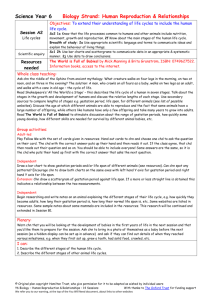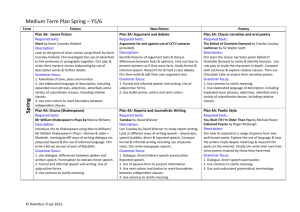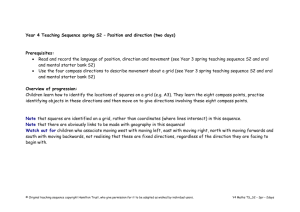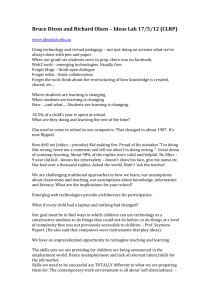Week 1 Monday 5th Oct 09
advertisement
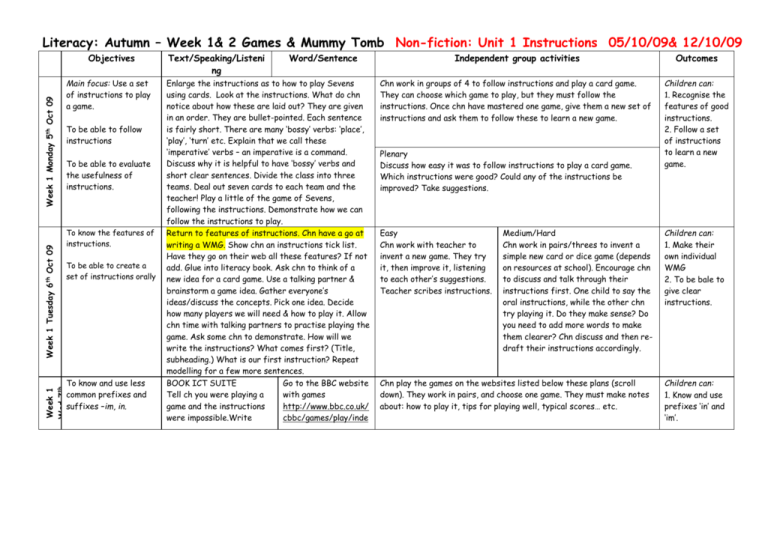
Literacy: Autumn – Week 1& 2 Games & Mummy Tomb Non-fiction: Unit 1 Instructions 05/10/09& 12/10/09 Main focus: Use a set of instructions to play a game. To be able to follow instructions To be able to evaluate the usefulness of instructions. To know the features of instructions. To be able to create a set of instructions orally To know and use less common prefixes and suffixes –im, in. Week 1 Wed 7th Oct 09 Week 1 Tuesday 6th Oct 09 Week 1 Monday 5th Oct 09 Objectives Text/Speaking/Listeni ng Word/Sentence Enlarge the instructions as to how to play Sevens using cards. Look at the instructions. What do chn notice about how these are laid out? They are given in an order. They are bullet-pointed. Each sentence is fairly short. There are many ‘bossy’ verbs: ‘place’, ‘play’, ‘turn’ etc. Explain that we call these ‘imperative’ verbs – an imperative is a command. Discuss why it is helpful to have ‘bossy’ verbs and short clear sentences. Divide the class into three teams. Deal out seven cards to each team and the teacher! Play a little of the game of Sevens, following the instructions. Demonstrate how we can follow the instructions to play. Return to features of instructions. Chn have a go at writing a WMG. Show chn an instructions tick list. Have they go on their web all these features? If not add. Glue into literacy book. Ask chn to think of a new idea for a card game. Use a talking partner & brainstorm a game idea. Gather everyone’s ideas/discuss the concepts. Pick one idea. Decide how many players we will need & how to play it. Allow chn time with talking partners to practise playing the game. Ask some chn to demonstrate. How will we write the instructions? What comes first? (Title, subheading.) What is our first instruction? Repeat modelling for a few more sentences. BOOK ICT SUITE Go to the BBC website Tell ch you were playing a with games game and the instructions http://www.bbc.co.uk/ were impossible.Write cbbc/games/play/inde Independent group activities Outcomes Chn work in groups of 4 to follow instructions and play a card game. They can choose which game to play, but they must follow the instructions. Once chn have mastered one game, give them a new set of instructions and ask them to follow these to learn a new game. Children can: 1. Recognise the features of good instructions. 2. Follow a set of instructions to learn a new game. Plenary Discuss how easy it was to follow instructions to play a card game. Which instructions were good? Could any of the instructions be improved? Take suggestions. Easy Chn work with teacher to invent a new game. They try it, then improve it, listening to each other’s suggestions. Teacher scribes instructions. Medium/Hard Chn work in pairs/threes to invent a simple new card or dice game (depends on resources at school). Encourage chn to discuss and talk through their instructions first. One child to say the oral instructions, while the other chn try playing it. Do they make sense? Do you need to add more words to make them clearer? Chn discuss and then redraft their instructions accordingly. Chn play the games on the websites listed below these plans (scroll down). They work in pairs, and choose one game. They must make notes about: how to play it, tips for playing well, typical scores… etc. Children can: 1. Make their own individual WMG 2. To be bale to give clear instructions. Children can: 1. Know and use prefixes ‘in’ and ‘im’. Literacy: Autumn – Week 1& 2 Games & Mummy Tomb Non-fiction: Unit 1 Instructions 05/10/09& 12/10/09 Week 1 Friday 9th Oct 09 Week 1 Thursday 8th Oct 09 Objectives Text/Speaking/Listeni ng Word/Sentence To identify good instructions an justify why, impossible on the f/c. Under-line the prefix: ‘im’. Explain that this means ‘not’. Brainstorm other ‘im’ words (p57 NLS Spelling Bank). Remind chn that ‘in’ is the same. To be able to speak clear instructions for a game. Recap WMG. Ch go out onto the playground. As a group they have to chalk onto the ground a hopscotch. They play the game so that they understand the rules. x.shtmlAllow chn time to play some of the games. Discuss with chn what makes a good game. How do we find out how to play it (largely trial and error). Model putting an action to the spoken sentence. eg First pick up a stone. To be able to put an action to an instruction to remember it. To be able to write a story. Big Writing V – Change boring words for WOW words. C- Start a sentence with a given connective. O- ing/ly openers P- Give chn unpunctuated text for them to put in punctuation. Independent group activities Plenary Look at one of the games. Look at instructions. Do they use any of the features we have looked at? Were they good? Get the children to justify why the game they played had good instructions. 2. Realise what instructions will be needed to learn how to play an online game. Children work as a group to put an action to each instruction and create a group spoken set of instructions. CT to record each group. Children can: Orally speak clear instructions. Rehearse clear instructions and remember the order Plenary Play the sound file to the class. Assess if the instructions are using the features. Use story start from Espresso – scary - crop circles. Chn to use a s a stimulus to write a scary story. Outcomes Children writing their story. Does it have the B, M and end? Does it have a plot with a conflict and resolution? Chn to highlight examples in their writing of features from WMG narrative. The children will have a written an extended piece of narrative Literacy: Autumn – Week 1& 2 Games & Mummy Tomb Non-fiction: Unit 1 Instructions 05/10/09& 12/10/09 Week 2 Tuesday 13th Oct 09 Week 2 Monday 12th Oct 09 Objectives Text/Speaking/Listening To know the features of instructions. To be able to design a modern day tomb. To understand the importance of giving precise instructions. To be able to give clear oral instructions. Word/Sentence Recap the features of clear instructions by referring to WMG from last week. Review some of the game instructions on an interactive screen. Focus on the sentence structure. Are the sentences on the whole short or long? Why? (Because it is too confusing if there are lots of words.) Why do they often begin with a verb? (It cuts out more words and makes it clear what you have to do right from the start.) Have they used any bullet points or paragraphing? Class teacher to dress up as Miss Muddle (a muddled up teacher). Return to the classroom and ask the children to give instructions to draw a stick a man. e.g. draw a circle-teacher to draw a huge circle. This should show that the instructions need to be precise and clear. Class teacher to return. “I bumped into another teacher as I came back, she said you were giving instructions about how to make a stick man.” Ask children to write down an instruction. Use doc cam to share 3. Underline imperative verb and model up-levelling. Independent group activities Easy/Medium/Hard Tell children that this week we are going to be planning and writing instructions for making a modern day tomb out of lego for a mummy. E. G instead of a pyramid what could it be like? Show ch some photos of different architecture (modern like Oscar Nemeiyer to encourage thinking outside the box). link to history and mummification. Allow ch time to play with lego and make their design – bearing in mind that they are going to write instructions explaining how someone else can make it. Plenary Take photographs of each child’s design and allow time for ch to circulate room to see each others designs. . Children work in mixed ability pairs. One turns there back on the other, so working blindly and gives instructions to the other to build their tomb. Can the child follow the instructions and rebuild the tomb? Switch over. Class teacher to record pairs giving instructions with microphone. Plenary Play the sound files created from the focus children. Pause after each instruction. Was that a clear instruction? Did they sue an imperative verb? Children to all up level one of the heard instructions. Outcomes Children can: 1. Children can list the features of instructions 2. Children make a design for a tomb. Children can: 1. Give clear oral instructions 2. Can identify imperative verbs, Literacy: Autumn – Week 1& 2 Games & Mummy Tomb Non-fiction: Unit 1 Instructions 05/10/09& 12/10/09 Text/Speaking/Listening To be able to give instructions orally. Word/Sentence Independent group activities Class teacher to dress up as Miss Muddle again (a muddled up teacher). Return to the classroom and ask the children to give instructions to making a sandwich. e.g. put the butter on the bread. Teacher to literally put whole slab on bread. This should reiterate that the instructions need to be precise and clear. Children have lego. They need to follow the instructions to create the tomb. There will be a poor example of instructions but have diagrams. Ch evaluate the usefulness of the instructions. Give the ch a good set of instructions to follow to create the same thing. Children evaluate the usefulness of the instructions. To be able to use adverbs to improve a spoken sentence. Give out the adverb cards. Ch say an instruction to their friend using the adverb related to their tomb design. eg- place the red rectangular piece on the top of the square cautiously. Ch working in pairs to talk through their design. This time not blind, child a - say the sentence, child b – follow the instruction. If child B doesn’t understand then child a has to say sentence again and add an imperative verb or colour to add detail etc. Class teacher to work in a guided group with Brackets and record the spoken instructions for building their tomb as a group. This group will write the same instructions. DH- to work with a whole group – Apostrophes Take one action from each group and then whole class have a set action for each feature. Act it out. CT to record as a video and upload to PC. Big Writing- instructions VCOP: Recap features by showing video of actions and then repeat the actions. Acting out the WMG. To be able to identify what makes instructions clear. Week 2 Friday 16th Oct 09 Week 2 Thursday 15th Oct 09 Week 2 Wednesday 14th Oct 09 Objectives To be able to write instructions for a modern day mummy tomb. Recap WMG instructions. Tell the children they need to work in groups to come up with an action to remember each feature. e.g. bossy verbs – hands on hips, bullet points – a punch forward. Have an action for each and recite. Ch write clear instructions for building their tomb. Give the children their photo of their design to glue on their instructions as a diagram. Also have their model in front of them so they can build it Outcomes Children can: 1. Identify good and bad instructions and justify why. Plenary Put the A and B instructions under the doc cam. Discuss why and what made them effective. Why they were hard to follow etc. Children write their instructions. Put punc target at top of page and then self assess with oops and wahey at bottom. Children will know what an adverb is and its effect on writing. Children will have spoken clear instructions to create a modern day mummy tomb. Chidlren will be able to write clear instructions Chidlren will eb able to evalute wheter instrucitons are Literacy: Autumn – Week 1& 2 Games & Mummy Tomb Non-fiction: Unit 1 Instructions 05/10/09& 12/10/09 Objectives Text/Speaking/Listening Imperative verbs. In one minute write down ans many as can think of, share. Adverbs: Give all a sentence and up level. Word/Sentence as they write to remember each step. Independent group activities Use doc cam to show some instructions. If time, CT to record a child reading out their instructions. Class to listen back and evaluate whether they think they could follow those instructions and create the tomb. Outcomes clear or why it is they are not.




